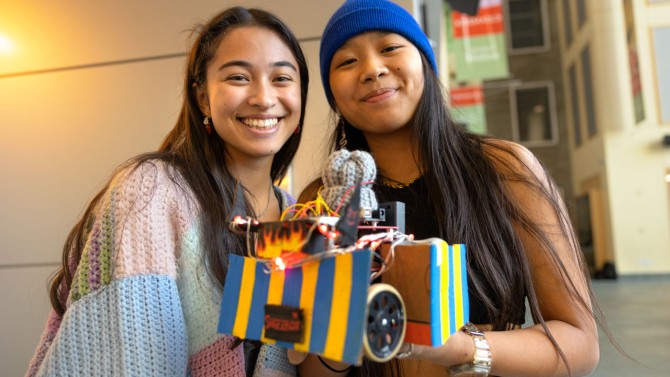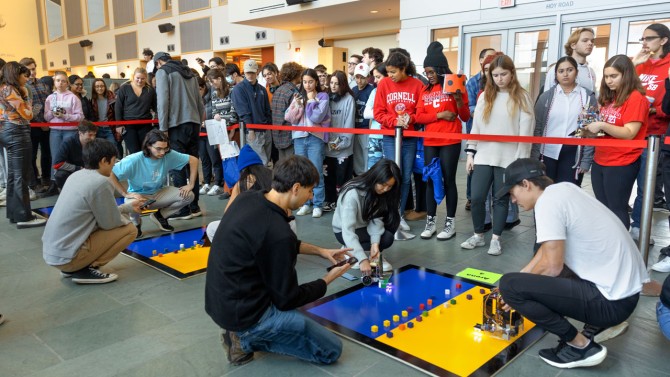Fifty-three student teams in the College of Engineering vied for the chance to beat corporate sponsor, ASML in the annual Mechatronics robotics competition.
Cube crazy: Simple strategy pays off in robotics final
By Laura Gallup, Cornell Chronicle
Simplicity was a winning strategy for a trio of engineering students in the annual Cornell Robotics Competition, held Dec. 1 in the Duffield Hall atrium.
The champion student group, Team 36, included Young June Park, a doctoral candidate in mechanical engineering; Will Campisi ’24; and Christina Wang ’24. Entering the round of 16 as the No. 2 seed, Team 36 won twice to advance to the final, where it defeated the top seed, Hasbulla (Team 11).
After capturing the student final, Team 36 fell in a best-of-3 series to the robot from corporate sponsor ASML. Team 36 won the first match, before ASML took the next two. It marked a bit of redemption; last year, ASML lost to the student champion for just the second time since the Dutch chip manufacturer began sponsoring the event in 2013.
Park said his team stuck to the basics in building the winning bot.
“We mainly focused on simplicity and robustness of the robot,” he said. “Our basic goal was to make the robot get its job done without any malfunctions, both in hardware and software. Our original design had much more complicated strategy and functions – like more sensors and foldable arms – but we decided to simplify the design as much as possible to secure the performance and avoid unforeseen errors.”
After weeks of coding, designing, testing and tweaking their machines, the 53 student teams competed in six initial rounds to shrink the pool down into a single-elimination bracket.
Each round of the competition began with two robots on a 4-foot-square, yellow-and-blue board, with 10 small blocks on each side. The challenge: to finish the minute-long round with more blocks on your side than your opponent’s. The atrium buzzed with excitement from a cheering crowd and the sound of a gong denoting the beginning of each round.
The robots served as final projects for mechanical engineering students in the Mechatronics class taught by Hadas Kress-Gazit, the Geoffrey S.M. Hedrick Sr. Professor in the Sibley School of Mechanical and Aerospace Engineering.
Kress-Gazit said students in her class learn how to build circuits and program Arduino boards – a circuit board with a microcontroller – which are used to as the brains of the robots. She said every year she is surprised by the range of designs and strategies that students come up with after working for about three weeks on the robots.
“I think the ones that are most successful are the ones that try not to overcomplicate it, and that test a lot,” Kress-Gazit said. “Because a lot of times people have really grandiose plans, and they just don’t quite have enough time to finish it, and they didn’t test it, and then it doesn’t work out.”
While many teams programmed their robots to collect blocks and head back to their side using technology that differentiated between the colors of the board, the Chassis Boys had a different strategy. Their robot employed a spinning arm – dubbed “the slapshot” – that knocked blocks back toward their side of the board.
“We didn’t want to deal with the color sensing or any of that,” said Zach Buttrick ’24, a mechanical engineering student. “We don’t care where the robot ends up … it just has to hit as many cubes back as possible.”
In each match, Buttrick’s robot drove to the other side of the board, turned 90 degrees, and moved along the board while the arm sent blocks whizzing back to its side – all without a remote control.
“It has a programmed path that it just has to hope it stays on,” said Buttrick, whose robot dominated the early rounds but was eliminated in the round of 16 by the eventual champion. “If it hits another robot, there's not really anything we can do about that.”
Sophia Alonso ’24 and her teammates built a cat-inspired robot and dealt with plenty of challenges. As the deadline loomed to submit a draft of their design, they found out the Arduino board was faulty.
“Apparently it was not our code, but it was the hardware that was not working,” Alonso said. “So we had to rewire everything into a new Arduino board. So that was really stressful.”
The day before competition, Alonso’s team also realized their robot didn’t comply with some of the rules. Robots had to fit in an 8-by-8-inch box (with no height restriction) at the beginning of the competition. Once the round begins, robots can deploy arms that extend farther – as long as it still fits within a 12-inch circle. This is a slight change from last year, where the circle was 18 inches in diameter.
“We had to do some last-minute changes because our arm was too big,” Alonso said. “We had to change the entire arm to be able to compete.”
Kress-Gazit said the team project teaches students how to work together and allows them to see a product come full circle through the design, build and test processes.
“They build a system from scratch, basically,” Kress-Gazit said. “You have constraints, you have design restrictions, we have a limited budget that we give them. I think the teamwork, the creativity, the kind of open-endedness of this is very, very good for them to experience. That’s engineering work in the future.”
Ken Bogursky ’96, director of mechanical development at ASML, started the competition between Cornell and ASML to engage with a new generation of engineers. It was such a success that now ASML hosts an internal competition to determine which robot will to travel to Ithaca and battle the student winner.
ASML had a table set up during the competition where employees and students could chat and network. Bogursky said it’s a great way to recruit; his company hires about 10 Cornell graduates each year.
“We love sponsoring young talent,” Bogursky said. “Cornell is one of the best engineering schools in the world. They have a strong mechatronics focus and ASML is a mechatronics company, so it’s a great way to help foster the development of future engineers. And if some of them happen to come our way, then even better.”
Bogursky reflected fondly on his time at Cornell, especially taking part in hands-on projects like this robotics challenge.
“The thing I see about Cornellians is, they’re not afraid to learn and not afraid to try new things,” Bogursky said. “I think Cornell prepares students for learning, basically, and not just textbook knowledge, but learning how to learn. Learning how to solve problems for themselves and leverage other people and other resources and to just keep on building upon that. I think that’s unique to the Cornell experience.”
Media Contact
Get Cornell news delivered right to your inbox.
Subscribe


